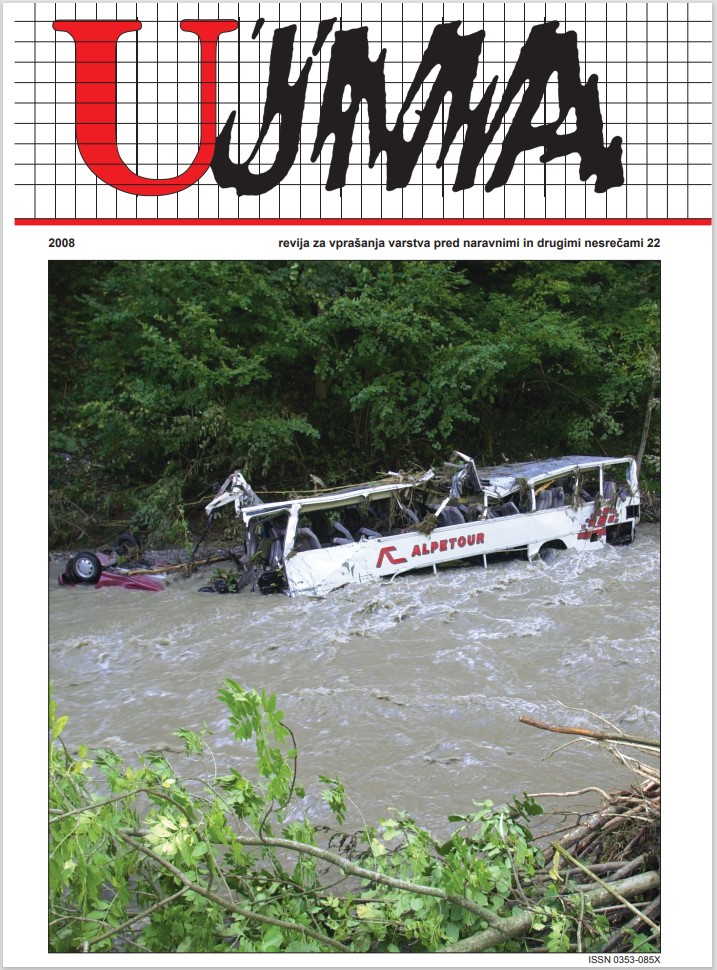COMPLEX SECURITY CRISIS RESPONSE IN SLOVENIA: NORMS, STRUCTURES AND FUNCTIONS
Abstract
This article is based on the assumption that modern security crises are showing an increasingly distinct growth in quantity and major changes in quality, evident in the endemic nature of crises, their composition, duration and complexity. The trend in major modern crises is their impact across national borders, their spread from one area of society to another and their connection to existing societal problems that are further exacerbated by the crises. The changing dimensions of modern crises have a direct influence on crisis management and leadership, wherein the conventional forms of organisation and coordination are no longer adequate. A new thinking is needed regarding policy and the capacities for responding to crises, a thinking that will take into account the national and international level of this problem. The aforementioned characteristics of crisis and crisis management and leadership are also strongly affecting Slovenia, which has a relatively well developed crisis management and leadership within individual government departments, but has not established adequate coordination between them, in other words on the national, strategic, level. This article comprises a short theoretical consideration of crises and crisis management, results of analysis of the legal structure governing this field in Slovenia, a subjective view from the administrative structure of crisis management and leadership and concluding recommendations and proposals for creating an integrated system of crisis management and leadership in Slovenia.
References
Beck, U., 1992. Risk Society. London: Sage.
Boin, A., Lagadec, P., 2000. Preparing for the Future: Critical Challenges for the Future. Journal of Contin gencies and Crisis Management . Vol. 8, No. 4, str. 185–191.
Boin, A., t'Hart, P., Stern, E., Sundelius, B., 2005. The Politics of Crisis Management: Public Leadership under Pressure. Cambridge: Cambridge University Press.
Brandstrom, A., Malešič, M. (eds.), 2004. Crisis Management in Slovenia: Comparative Perspectives. Stockholm: CRISMART.
Crises to Come: Comments and Findings. Partici pants: Yehezkel Dror, Patric Lagadec, Boris Porfiriev, Enrico L. (Henry) Quarantelli. Moderators: Uriel Rosenthal, Arjen Boin and Louise K. Comfort. V: Rosenthal, Uriel, Arjen R. Boin and Louise K. Comfort (2001): Managing Crises: Threats Dilemmas, Oppor tunities. Springfield: Charles C Thomas Publisher Ltd.
Grizold, A., 2005. Slovenija v spremenjenem varno stnem okolju. Ljubljana: Fakulteta za družbene vede.
Grönvall, J., 2000. Managing Crisis in the European Union: The Commission and “Mad Cow” Disease, V: ur. Sundelius B., Stockholm A Publication of the Crisis management Europe Research Program, CRISMART, Vol.10/2000.
Johansson, I., Skoglung, P. (eds.), 1996. Crisis Mana gement at the National Level. Stokholm: OCB.
Krizno upravljanje in vodenje (interna analiza), Ljubljana: MORS, 2001.
Malešič, M. (ur.), 2004. Krizno upravljanje in vodenje v Sloveniji. Izzivi in priložnosti. Ljubljana: Fakulteta za družbene vede.
Malešič, M., Hrvatin, Sandra B., Polič M., 2006. Komuniciranje v krizi. Ljubljana: Fakulteta za družbene vede.
Nacionalni program varstva pred naravnimi in drugimi nesrečami, Ljubljana: URSZR, 2002.
Napotnik, D., 2003. Analiza kriznega upravljanja in vodenja v RS, Ljubljana: MORS.
Porfiriev, B. and Svedin, L. (eds.), 2002. Crisis Management in Russia. Overcoming Institutional Rigidity and Resource Constraints. Stockholm: CRISMART.
Poslovnik Medresorske delovne skupine za sode lovanje Republike Slovenije z Natom in članicami Partnerstva za mir, 2000.
Prezelj, I., 2005. Nacionalni sistemi kriznega mene džmenta. Ljubljana: Fakulteta za družbene vede.
Prezelj, I., 2006. Svet za nacionalno varnost in Nacio nalni center za krizno upravljanje kot ključna varnostna integracijska mehanizma v Republiki Sloveniji. V: Malešič, M. (ur.)., 2006. Varnost v postmoderni družbi. Ljubljana: Fakulteta za družbene vede.
Prezelj, I., Malešič, M., Vehovar, V., Svete, U., Kopač, E., Grošelj, K., 2006. Model ocenjevanja ogrožanja naci onalne varnosti: I. podprojekt: končno raziskovalno poročilo. Ljubljana: Univerza v Ljubljani, Fakulteta za družbene vede, Obramboslovni raziskovalni center.
Quarantelli, E. L., 1996. The Future is not the Past Repeated: Projecting Disasters in the 21st Century from Current Trends. Journal of Contingencies and Crisis Management . Vol. 4, No. 4, str. 228–240.
Rosenthal, U., Boin A. R. and Comfort, L. K., 2001. Managing Crises: Threats Dilemmas, Opportunities. Springfield: Charles C Thomas Publisher Ltd.
Stern, E. K., 1999. Crisis Decisionmaking: A Cognitive Institutional Approach. Stockholm: OCB.
Ustava RS, Uradni list RS, št. 33I/91-I, 42/97, 66/00, 24/03, 69/04, 69/04, 69/04, 68/06.
Zakon o državni upravi, Uradni list RS, št. 52/02, 56/03, 61/04, 123/04, 93/05. 144 številka 22, 2008
Zakon o obrambi, Uradni list RS, št. 82/94, 44/97, 87/97, 47/02, 40/04.
Zakon o zunanjih zadevah, Uradni list RS, št. 45/01, 78/03.
Zakon o varstvu pred naravnimi in drugimi nesrečami, Uradni list RS, št. 64/94, 28/06.
Zakon o policiji, Uradni list RS, št. 49/98, 93/01, 79/03, 50/04, 53/05, 98/05, 78/06.
Odlok o svetu za nacionalno varnost, Uradni list RS, št. 135/04, 45/05.
Uredba o organizaciji in delovanju Nacionalnega centra za krizno upravljanje, Uradni list RS, št. 9/2006.
Uredba o obrambnih načrtih, Uradni list RS, št. 11/04.
Uredba o vsebini in izdelavi načrtov zaščite in reševanja, Uradni list RS, št. 3/02, 17/06.
Resolucija o strategiji nacionalne varnosti Republike Slovenije, Uradni list RS, št. 56/01.
Resolucija o splošnem dolgoročnem programu razvoja in opremljanja Slovenske vojske, Uradni list RS, št. 89/04.
Vojaška doktrina, Vlada RS, 1. junij 2006.
Nacionalni program varstva pred naravnimi in drugimi nesrečami, Uradni list RS, št. 44/02.
Doktrina zaščite, reševanja in pomoči, Vlada RS, 30. maj 2002.
Doktrina civilne obrambe, Uradni list RS, št. 56/01.
Downloads
Published
Issue
Section
License

This work is licensed under a Creative Commons Attribution-NonCommercial-NoDerivatives 4.0 International License.
The articles are made available to the public under Creative Commons Attribution-NonCommercial-NoDerivatives 4.0 International (CC BY-NC-ND 4.0).


